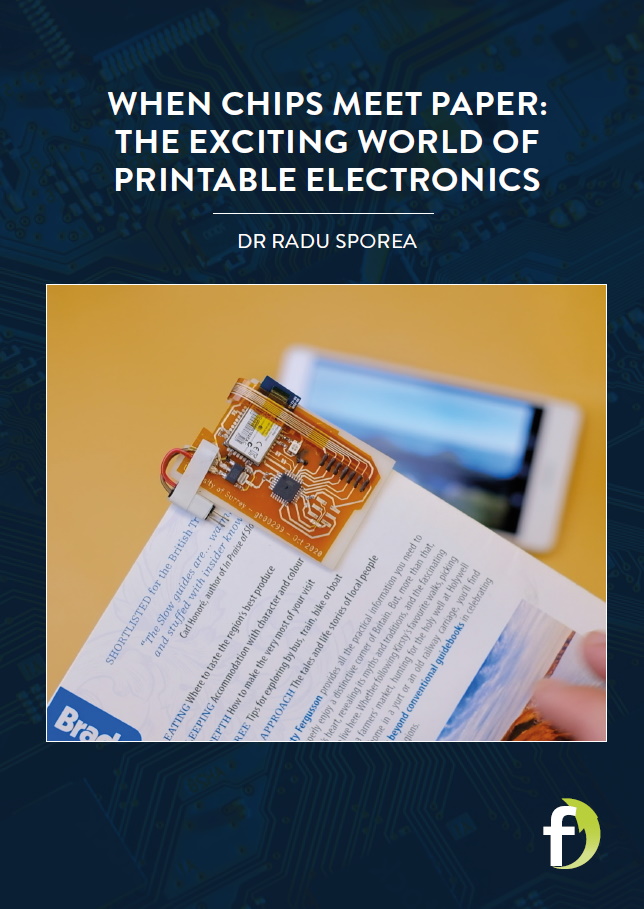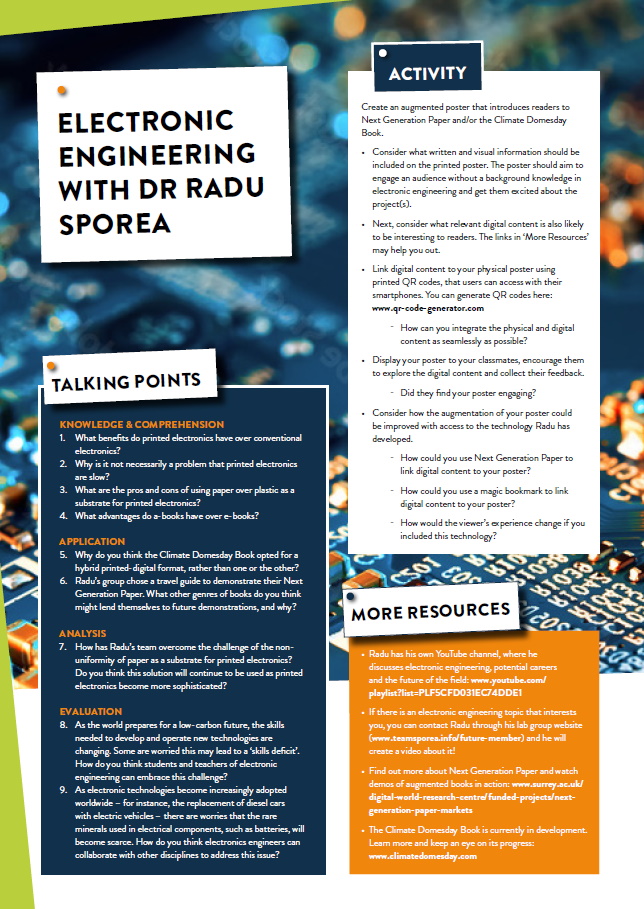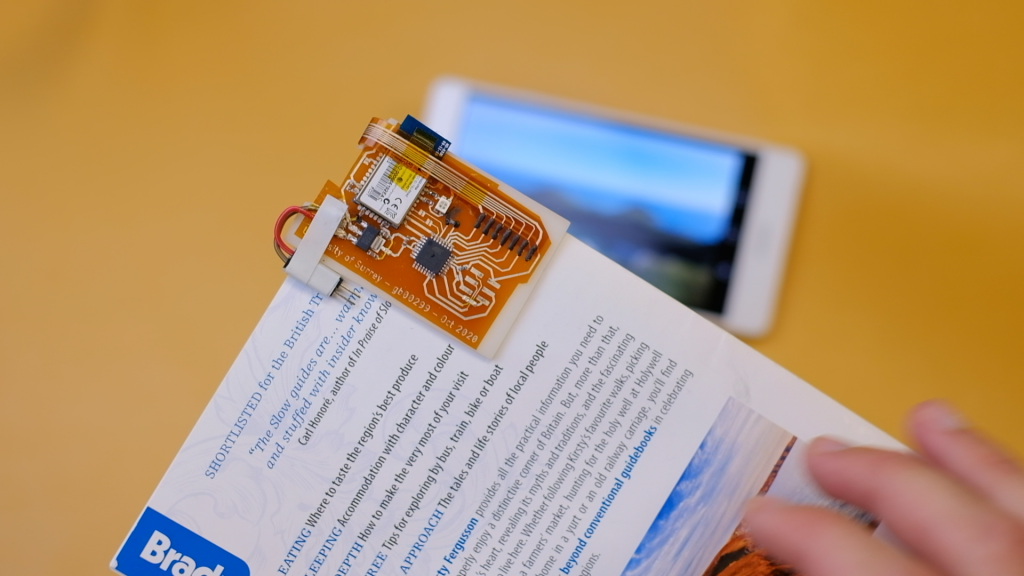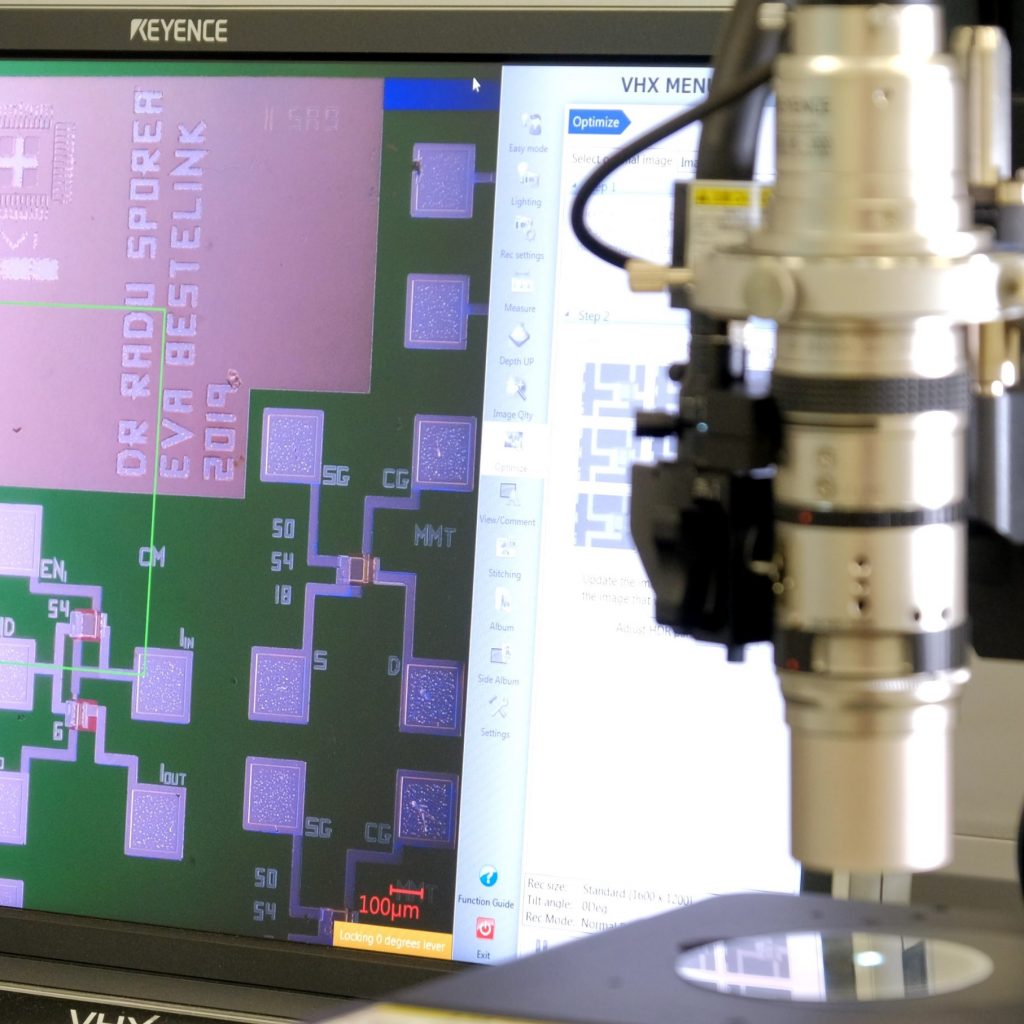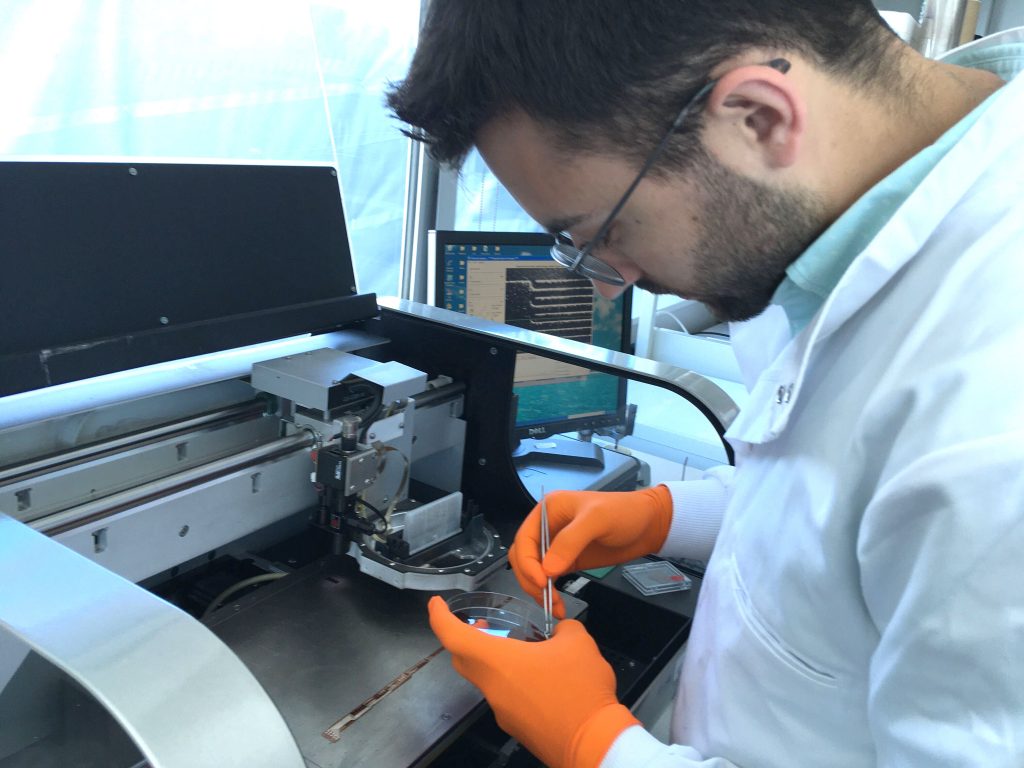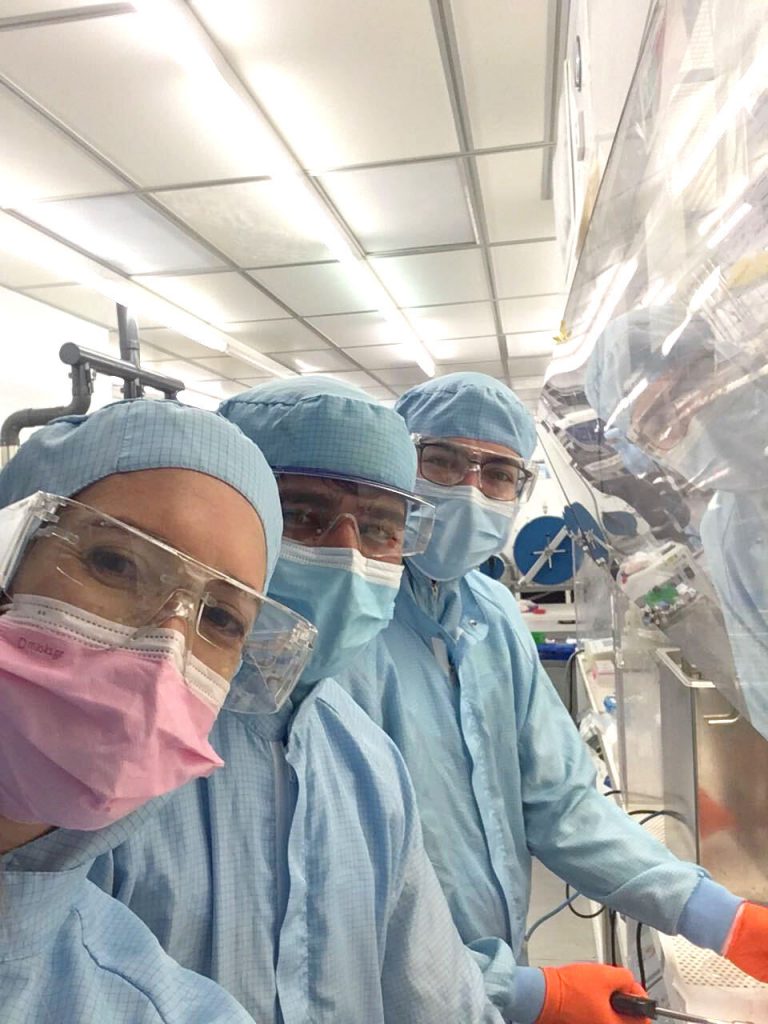When chips meet paper: the exciting world of printable electronics
Electronics are entering a new phase. At the University of Surrey in the UK, Dr Radu Sporea is leading a team investigating how to ‘print’ circuits onto paper, creating devices that combine the physical and digital worlds. This is opening new possibilities for flexible, integrated electronics, while simultaneously promoting economical and environmental benefits
TALK LIKE AN ELECTRONICS ENGINEER
CIRCUIT – in electronics, a route that allows electricity to flow from one point to another, through one or more electrical or electronic components
CONDUCTOR – a material that can carry electrical charge when voltage is applied
INSULATOR – a material that cannot carry electrical charge
SEMICONDUCTOR – a material with conductivity that can be modified while in operation, by interactions with heat, light or electric fields. Semiconductors serve as the basis of electronic devices
SILICON CHIP – a fingernail-sized object composed of semiconductor, conductor and insulator materials that holds miniaturised electronic circuits. These circuits are capable of performing operations like signal amplification, logic tasks and storing information
SUBSTRATE – the underlying substance that something of interest is attached to
The age of electronics is flourishing. The phone in your pocket is thousands of times more complex than the Apollo Guidance Computer that put the first human on the moon. We live in a world surrounded by incredibly high-performing technologies that make our lives easier and more connected.
However, there is a catch. Our rapidly-evolving electrical and electronic machines require a lot of energy and materials to make. Metals such as cobalt, copper, neodymium and indium must be mined from the Earth, a process that often has large environmental and ethical costs. Then, after these products come to the end of their life, there is the problem of their disposal. Electronics are difficult to recycle and can leak toxic substances if not disposed of correctly. Solutions are therefore needed to make electronics less resource-intensive.
NEW TYPES OF ELECTRONICS
“The silicon chips we use in our phones, computers, cars and anything else electronic are rigid, fast and comparatively expensive to make,” says Dr Radu Sporea, Senior Lecturer in Electronic Engineering at the University of Surrey. “However, it is possible to make circuits with basic functions with much cheaper technologies and substrates.” While comparatively slow, these electronics can be ‘printed’ onto cheap materials, such as paper or plastic, creating a whole range of possibilities for flexible electronics.
These printable electronics could fulfil functions that do not require standard high-performing silicon chips. For instance, when measuring environmental variables that change slowly, such as temperature, air pollutants or a person’s pulse, it does not matter if the electronics are also slow. “Making these printed circuits uses far less energy, fewer harmful materials and much cheaper equipment,” says Radu. “They can also be made to be flexible, transparent and extremely large, if needed.”
THE PRINTING PROCESS
So, how can electronics be ‘printed’? “The process is more similar to printing magazines than it is to producing conventional silicon chips,” says Radu. “Layer by layer, the constituent parts of the electronic devices are stamped, etched or printed onto a continuous roll of eco-friendly plastic or paper that is then cut into individual chips.” The ‘inks’ used by these printers are specially formulated to have conductor, insulator or semiconductor properties. Printing different combinations of these inks can build electronic components from the ground up, as well as the wires that connect them, enabling functional circuits to be printed directly on low-cost substrates.
“A lot of science and engineering goes into getting these components right,” says Radu. “From the ink properties to the alignment of the printed features, everything is carefully researched.” There is still a lot to learn in this process. Over time, Radu believes these printed applications could be made even thinner, with boosted performance and a greater range of possible functions.
PLASTIC VS PAPER
“Plastic is a convenient substrate to print onto and can sometimes be biodegradable, but paper is also attractive as a more ecological alternative,” says Radu. “The main issue with paper is that, while plastic sheets can be made smooth at the microscopic level, paper is made of relatively large fibres meshed together.” This is a problem, as the ‘landscape’ that the components are printed onto will be very non-uniform, full of bumps and ridges, meaning it can be difficult to ensure the reliability of the electronics created.
Radu’s team has developed an ingenious way of overcoming this problem. “In any electronic circuit, contact between a metal and a semiconductor creates an energy barrier that is normally surmounted by electrical charges,” he explains. “In contrast with most electronics design, we use this barrier deliberately in our work, as a way of regulating how much current can flow. This ensures that components that end up being not quite identical, due to variations in the manufacturing or substrate properties, can still have the same behaviour.” Even though this makes the circuit “embarrassingly slow” compared to standard circuits in silicon chips, this is not a problem for the applications such flexible circuits are designed for, in which a regular and predictable current is far more important than speedy processing power.
APPLICATIONS OF PRINTED ELECTRONICS
NEXT GENERATION PAPER
Radu’s group has teamed up with other researchers to put these ideas into practice. “Next Generation Paper is an interdisciplinary project to design a meaningful way to add digital information to a paper book,” says Radu. Unlike an e-book, which is a digital book viewed on an electronic screen, an augmented book, or a-book, is a paper book linked with additional digital content.
“We chose to demonstrate Next Generation Paper on a travel guide, as it embodies both the benefits and shortcomings of paper books.” Travel guides have the look and feel of books that many people like, can easily be carried around, are robust and do not depend on an internet connection. However, their information becomes outdated over time and they cannot display audio or visual information.
“For our augmented travel guide, we used simple electronics to enable the book to ‘know’ what page is being read by printing light sensors on every page,” explains Radu. “By connecting these to a simple decision circuit and a transmitter, the book relays this information to a nearby device such as a smartphone, which then displays relevant content.” This might be videos of destinations, up-to-date opening times for a venue or recent reviews of an attraction. “We have kept the interaction with the book as natural as possible, so as not to detract from the reading experience and the ‘bookness’ of the book,” he says.
THE MAGIC BOOKMARK
As an alternative to light sensors and electronics within the book, Radu’s team has developed a ‘magic bookmark’ that, when placed on a page, reads an invisible code printed on the page and sends this to a nearby smart device, which will then access related digital content. “The idea is to use a natural gesture – the handling of the bookmark – rather than the fairly widespread action of pointing a smartphone camera at a page, which would interrupt the reading experience,” says Radu.
The team is bringing this bookmark to life with a unique new tome, the Climate Domesday Book. This book will compile contributions from scientists and artists from around the world, exploring ideas about climate change, energy use and the future of our planet. “The book has been designed to be a hybrid printed-digital format,” says Radu. “The magic bookmark will be used to seamlessly connect up-to-date multimedia content with the printed information.”
Reference
https://doi.org/10.33424/FUTURUM271
CIRCUIT – in electronics, a route that allows electricity to flow from one point to another, through one or more electrical or electronic components
CONDUCTOR – a material that can carry electrical charge when voltage is applied
INSULATOR – a material that cannot carry electrical charge
SEMICONDUCTOR – a material with conductivity that can be modified while in operation, by interactions with heat, light or electric fields. Semiconductors serve as the basis of electronic devices
SILICON CHIP – a fingernail-sized object composed of semiconductor, conductor and insulator materials that holds miniaturised electronic circuits. These circuits are capable of performing operations like signal amplification, logic tasks and storing information
SUBSTRATE – the underlying substance that something of interest is attached to
The age of electronics is flourishing. The phone in your pocket is thousands of times more complex than the Apollo Guidance Computer that put the first human on the moon. We live in a world surrounded by incredibly high-performing technologies that make our lives easier and more connected.
However, there is a catch. Our rapidly-evolving electrical and electronic machines require a lot of energy and materials to make. Metals such as cobalt, copper, neodymium and indium must be mined from the Earth, a process that often has large environmental and ethical costs. 1Then, after these products come to the end of their life, there is the problem of their disposal. Electronics are difficult to recycle and can leak toxic substances if not disposed of correctly. Solutions are therefore needed to make electronics less resource-intensive.
NEW TYPES OF ELECTRONICS
“The silicon chips we use in our phones, computers, cars and anything else electronic are rigid, fast and comparatively expensive to make,” says Dr Radu Sporea, Senior Lecturer in Electronic Engineering at the University of Surrey. “However, it is possible to make circuits with basic functions with much cheaper technologies and substrates.” While comparatively slow, these electronics can be ‘printed’ onto cheap materials, such as paper or plastic, creating a whole range of possibilities for flexible electronics.
These printable electronics could fulfil functions that do not require standard high-performing silicon chips. For instance, when measuring environmental variables that change slowly, such as temperature, air pollutants or a person’s pulse, it does not matter if the electronics are also slow. “Making these printed circuits uses far less energy, fewer harmful materials and much cheaper equipment,” says Radu. “They can also be made to be flexible, transparent and extremely large, if needed.”
THE PRINTING PROCESS
So, how can electronics be ‘printed’? “The process is more similar to printing magazines than it is to producing conventional silicon chips,” says Radu. “Layer by layer, the constituent parts of the electronic devices are stamped, etched or printed onto a continuous roll of eco-friendly plastic or paper that is then cut into individual chips.” The ‘inks’ used by these printers are specially formulated to have conductor, insulator or semiconductor properties. Printing different combinations of these inks can build electronic components from the ground up, as well as the wires that connect them, enabling functional circuits to be printed directly on low-cost substrates.
“A lot of science and engineering goes into getting these components right,” says Radu. “From the ink properties to the alignment of the printed features, everything is carefully researched.” There is still a lot to learn in this process. Over time, Radu believes these printed applications could be made even thinner, with boosted performance and a greater range of possible functions.
PLASTIC VS PAPER
“Plastic is a convenient substrate to print onto and can sometimes be biodegradable, but paper is also attractive as a more ecological alternative,” says Radu. “The main issue with paper is that, while plastic sheets can be made smooth at the microscopic level, paper is made of relatively large fibres meshed together.” This is a problem, as the ‘landscape’ that the components are printed onto will be very non-uniform, full of bumps and ridges, meaning it can be difficult to ensure the reliability of the electronics created.
Radu’s team has developed an ingenious way of overcoming this problem. “In any electronic circuit, contact between a metal and a semiconductor creates an energy barrier that is normally surmounted by electrical charges,” he explains. “In contrast with most electronics design, we use this barrier deliberately in our work, as a way of regulating how much current can flow. This ensures that components that end up being not quite identical, due to variations in the manufacturing or substrate properties, can still have the same behaviour.” Even though this makes the circuit “embarrassingly slow” compared to standard circuits in silicon chips, this is not a problem for the applications such flexible circuits are designed for, in which a regular and predictable current is far more important than speedy processing power.
APPLICATIONS OF PRINTED ELECTRONICS
NEXT GENERATION PAPER
Radu’s group has teamed up with other researchers to put these ideas into practice. “Next Generation Paper is an interdisciplinary project to design a meaningful way to add digital information to a paper book,” says Radu. Unlike an e-book, which is a digital book viewed on an electronic screen, an augmented book, or a-book, is a paper book linked with additional digital content.
“We chose to demonstrate Next Generation Paper on a travel guide, as it embodies both the benefits and shortcomings of paper books.” Travel guides have the look and feel of books that many people like, can easily be carried around, are robust and do not depend on an internet connection. However, their information becomes outdated over time and they cannot display audio or visual information.
“For our augmented travel guide, we used simple electronics to enable the book to ‘know’ what page is being read by printing light sensors on every page,” explains Radu. “By connecting these to a simple decision circuit and a transmitter, the book relays this information to a nearby device such as a smartphone, which then displays relevant content.” This might be videos of destinations, up-to-date opening times for a venue or recent reviews of an attraction. “We have kept the interaction with the book as natural as possible, so as not to detract from the reading experience and the ‘bookness’ of the book,” he says.
THE MAGIC BOOKMARK
As an alternative to light sensors and electronics within the book, Radu’s team has developed a ‘magic bookmark’ that, when placed on a page, reads an invisible code printed on the page and sends this to a nearby smart device, which will then access related digital content. “The idea is to use a natural gesture – the handling of the bookmark – rather than the fairly widespread action of pointing a smartphone camera at a page, which would interrupt the reading experience,” says Radu.
The team is bringing this bookmark to life with a unique new tome, the Climate Domesday Book. This book will compile contributions from scientists and artists from around the world, exploring ideas about climate change, energy use and the future of our planet. “The book has been designed to be a hybrid printed-digital format,” says Radu. “The magic bookmark will be used to seamlessly connect up-to-date multimedia content with the printed information.”
These projects demonstrate just a few of the potential applications for flexible printed electronics, highlighting how Radu and his team are developing technology that will advance the field of electronic engineering.
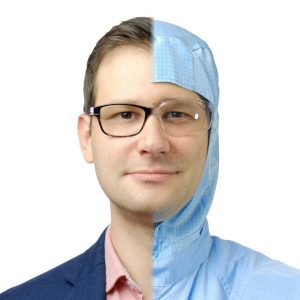 DR RADU SPOREA
DR RADU SPOREA
Advanced Technology Institute, Department of Electrical and Electronic Engineering, University of Surrey, UK
FIELD OF RESEARCH: Electronic Engineering
RESEARCH PROJECT: Creating printable electronics with sensory functionality, to be used in a range of innovative applications
FUNDER: Engineering and Physical Sciences Research Council (EPSRC)
 DR RADU SPOREA
DR RADU SPOREA
Advanced Technology Institute, Department of Electrical and Electronic Engineering, University of Surrey, UK
FIELD OF RESEARCH: Electronic Engineering
RESEARCH PROJECT: Creating printable electronics with sensory functionality, to be used in a range of innovative applications
FUNDER: Engineering and Physical Sciences Research Council (EPSRC)
ABOUT ELECTRONIC ENGINEERING
Electronic engineering involves the design and construction of circuits and electronic devices. These skills can be applied across a very diverse range of sub-disciplines. Radu explains more about the field:
As we’ve found in our projects, no single engineering discipline is sufficient for truly interesting breakthroughs. Our printable electronics projects require an understanding of electricity, semiconductors, device physics, maths, computer modelling, fluid dynamics, mechanics and chemistry, along with analogue and digital design, which is why we work in a team. In the Next Generation Paper project, the required disciplines widened even further, to include designers, graphics artists, anthropologists and business experts. This project is truly multidisciplinary and extremely rewarding.
The world is changing rapidly and so are the skills needed for engineering. Core skills to manage these changes include discipline, problem solving, tenacity, confidence and planning. A degree in electronic engineering prepares you to be agile and adaptable to the inevitable changes that will arise during your career.
Electronics engineers are needed in a wide range of areas. You could find yourself working in robotics, nanotechnology or sustainable energy generation, or contributing to efficient transportation, smart cities or personalised medicine.
There is likely to be a shortage of engineers for years to come, leading to high demand for competent specialists. The skills that you will develop as an electronics engineer will allow you to continue to specialise or to adapt to other fields, within or outside engineering, throughout your life.
EXPLORE CAREERS IN ELECTRONIC ENGINEERING
• Radu’s department at the University of Surrey runs free residential summer schools where students can sample different engineering disciplines: www.surrey.ac.uk/schools-colleges/sixth-form-colleges/residential-summer-schools
• Radu also runs summer research placements in his lab for sixth-form students, which have led to new scientific discoveries and academic publications: www.teamsporea.info/future-member
• Radu recommends looking for opportunities to participate in research while still at school, to get a feel for what electronic engineering involves. Contact universities near you, or look for schemes such as SATRO Research Work Placements (www.satro.org.uk/researchwork-placements) or Nuffield Research Placements (www.stem.org.uk/nuffield-research-placements)
• Electronics engineers are in high demand. Prospects provides information about the work you could do, the qualifications you will need and the salary you can expect as an electronics engineer: www.prospects.ac.uk/job-profiles/electronics-engineer
• At school and university, courses in maths, science subjects and computing will be useful for pursuing a career in electronic engineering.
• Radu notes that there are many routes to specialisation within the field. Maths, physics and coding are useful skills in his research area of circuit design and development. Many electronic devices are optimised at the molecular level, which requires knowledge of chemistry and materials science. Complex maths and coding are often needed for robotics and artificial intelligence research.
• There are also many opportunities for electronic engineering careers in equipment design and facilities maintenance, requiring more practical electrical skills.
• Look for companies that offer apprenticeships or internships. These will allow you to learn about electronic engineering while being paid and gaining valuable practical experience.
HOW DID RADU BECOME AN ELECTRONICS ENGINEER?
WHAT WERE YOUR INTERESTS WHEN YOU WERE YOUNGER?
I was keen on building models with Lego and Meccano, but not that much into electronics. When I was six, my parents enrolled me in a computer class and I began to enjoy programming, which gradually changed into an interest in computer hardware and then chip design.
HOW DID YOU BENEFIT FROM WORKING IN INDUSTRY AS A STUDENT?
Halfway through my degree in computer systems engineering, I was looking for a summer job and one of my professors recommended me to the local branch of a Silicon Valley chip company. I ended up working in circuit layout and design, where I contributed to new inventions that are now used in commercial chip designs, which resulted in a US patent. I enjoyed the research element of the work, so decided to do a PhD.
WHAT IS YOUR WORKING LIFE LIKE?
I teach first and third year undergraduate electronics students and lead a small, but highly capable, team of researchers who are developing the next generation of efficient, flexible and printed electronics. I want to improve technology to drive a better quality of life. I am fortunate to work with dozens of exceptional researchers from around the world in pursuing this goal.
WHAT ARE SOME HIGHLIGHTS OF YOUR CAREER?
I have been awarded two national research fellowships, which confirm the importance of my research and the uniqueness of my team’s approach. Awards for teaching have recognised my other great passion. Outside work, the births of my daughters reminded me to choose wisely about what to focus on and to consider what brings meaning in life.
WHAT IS NEXT FOR YOUR CAREER?
I am focusing on translating our research ideas into practical technologies that are economically viable, energy efficient and sustainable. I would love to see these concepts taken up by manufacturers, to help improve quality of life through ecologically-minded technologies.
WHY DO YOU ENJOY ENGAGING THE PUBLIC WITH ELECTRONIC ENGINEERING?
It’s important to show the reality of research and engineering, and that the satisfaction of creating something useful greatly outweighs the challenges that must be overcome. Modern electronics are impenetrable, so we need to make them accessible. The slick appearance of a smartphone conveys very little of its nanoscale physical constituents. If you can’t see what’s inside, you can hardly be tempted to explore the wonders of electronics.
On a personal level, I found public speaking exceptionally challenging early in life, so putting myself in these terrifying situations has helped my personal development. I still feel pressure whenever I speak in public, but I embrace it because I am confident in the importance of the interaction.
WHAT DO YOU ENJOY OUTSIDE OF WORK?
Spending time with my daughters is a top priority. I also play guitar – badly, but it brings me joy. And, I have an interest in travel, cars and photography, and I try to combine these whenever I visit research collaborators abroad.
RADU’S TOP TIPS
1. Don’t hesitate to ask for help in achieving your ambitions.
2. Allow time for thinking. If you’re busy all the time, it’s difficult to link ideas to create something new.
3. Eat well and get enough sleep. Your focus and creativity will skyrocket.
Do you have a question for Radu?
Write it in the comments box below and Radu will get back to you. (Remember, researchers are very busy people, so you may have to wait a few days.)

